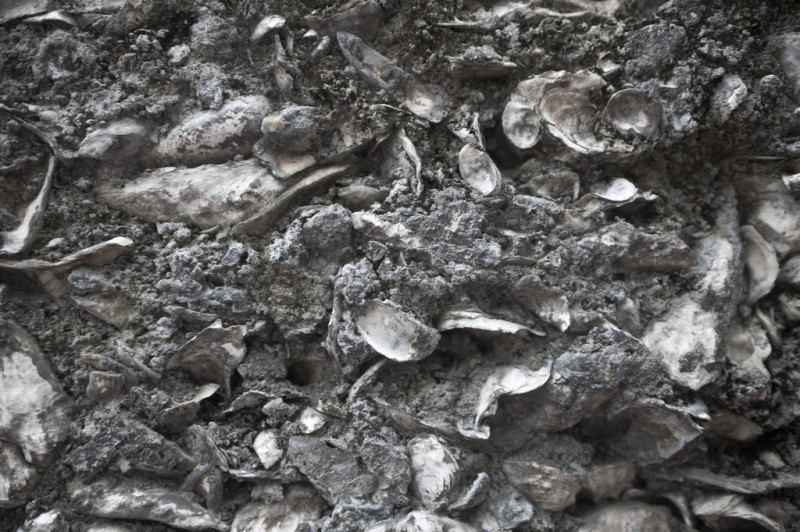tabby
From the elegantly sublime, Niemeyer, to the desperately expeditious:
 Tabby concrete. St. Augustine, Florida. Photo by Nathan Wolkenhauer, 2011In between Roman concrete and the discovery of Portland cement in 1830, there was tabby: burnt oyster shells (lime), mixed with water, sand and broken shell. Originally Moroccan, although North Africa was part of the Roman empire so it might be continuous with Roman concrete work, the use of tabby migrated to Spain and eventually to Spanish colonies, such as Florida, using broken shell as aggregate when stone was not available.
Tabby concrete. St. Augustine, Florida. Photo by Nathan Wolkenhauer, 2011In between Roman concrete and the discovery of Portland cement in 1830, there was tabby: burnt oyster shells (lime), mixed with water, sand and broken shell. Originally Moroccan, although North Africa was part of the Roman empire so it might be continuous with Roman concrete work, the use of tabby migrated to Spain and eventually to Spanish colonies, such as Florida, using broken shell as aggregate when stone was not available.
The lime/sand/water combination occurs all along the lower east coast of the USA, dating generally from the early 1700s. The oyster shells were found in huge middens left by the aboriginal peoples of the Atlantic coast. The reported size of the oyster shell piles, and the size of the shells themselves – 6 to 8" x 15 to 20", evidently oysters were gigantic in pre-historic times – indicates a cultural landscape rarely discussed and long vanished.There are shell middens on all coastlines, often thousands of years old, but not all were turned into sources of lime for concrete.
An article by Jingle Davis on the Tabby Trail on the southeast coast of the US tells how the shells were found, mined, fired, and the resultant lime and wood ash mixed with clean sand and water. Floors were laid and hammered with linseed oil into marble-like hardness. Walls were built up using slip forms.
Now, here's a recipe: ten bushels of lime, ten bushels of sand, ten bushels of shells and ten bushels of water gives you sixteen cubic feet of wall.
1 bushel = 8 gallons, so presumably a bushel of lime is enough lime to fill an eight gallon container. There is something suspiciously coincidental that all the components for tabby are in ten bushel portions. It might be loose science, done more by feel than precise measure.
It is interesting that the making of tabby almost replicates the process of producing calcareous limestone itself. There is something about all this lime, heat and water process that is strangely circular.
 A tabby building at the Kingsley Plantation on Fort George Island in Jacksonville, Florida. Tabby concrete was used in the 1700s and early 1800s in Florida and coastal Georgia. In this photograph, one can see the slip-form casting method uses, whereby each course is a seperate pour. When set the board formwork is moved up for the next pour. photo credit: State Archives of Florida, Florida Memory
A tabby building at the Kingsley Plantation on Fort George Island in Jacksonville, Florida. Tabby concrete was used in the 1700s and early 1800s in Florida and coastal Georgia. In this photograph, one can see the slip-form casting method uses, whereby each course is a seperate pour. When set the board formwork is moved up for the next pour. photo credit: State Archives of Florida, Florida Memory
